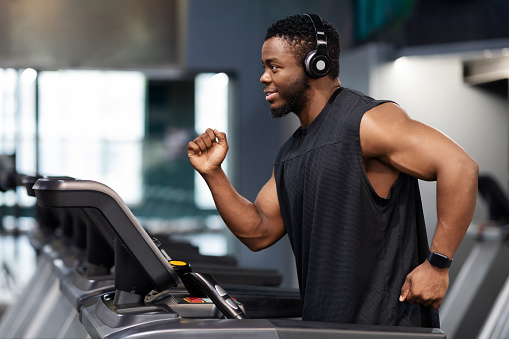In recent years, the fitness industry has witnessed a remarkable transformation, with technology playing a pivotal role in enhancing our workout experiences with wireless headphones. Compared to capacitive panels, resistive touch screen monitors use different technology. They are made up of several layers, including a top layer that is flexible and a bottom layer that is hard, separated by minuscule air spaces. The touch position is established by variations in electrical resistance brought on when pressure is applied to the top layer, which makes contact with the bottom layer.
1 .The Rise of Wireless Headphones in Fitness.

Wireless headphones have become increasingly popular among fitness enthusiasts for several reasons. First and foremost, they provide a wire-free experience, allowing for greater freedom of movement during workouts. Additionally, advancements in Bluetooth technology have improved the audio quality and connectivity of wireless headphones, making them a preferred choice for fitness enthusiasts who want to enjoy music or podcasts while exercising. The integration of biometric sensors takes these headphones to a whole new level, transforming them into comprehensive fitness tracking devices.
2. The Role of Biometric Sensors
Biometric sensors embedded in wireless headphones enable the collection of various physiological data during workouts. These sensors can measure heart rate, oxygen saturation, body temperature, and even track movements and distances covered. This real-time data provides users with valuable insights into their fitness performance and allows for personalized training programs tailored to individual needs. The convenience of having these sensors seamlessly integrated into wireless headphones eliminates the need for additional wearable devices, streamlining the fitness tracking process.
3. Accurate Heart Rate Monitoring
Heart rate monitoring is a fundamental aspect of fitness tracking, and biometric sensors in wireless headphones excel in this domain. By leveraging optical or electrical sensors, headphones can accurately measure heart rate by monitoring the blood flow through the ear or the surrounding tissues. This continuous and non-invasive heart rate monitoring during workouts helps users gauge their exertion levels, optimize training intensity, and ensure they are exercising within their target heart rate zones.
4. Oxygen Saturation and Performance Assessment
Some cutting-edge wireless earbuds have SpO2 sensors that gauge blood oxygen saturation levels. This statistic offers information on the effectiveness of oxygen delivery to muscles during exercise, which is important for evaluating performance and endurance. Users can assess their fitness levels, see early signs of exhaustion, and make educated judgements regarding their training intensity and recovery methods by keeping an eye on their oxygen saturation levels.
5. Movement Tracking and Distance Measurement
Biometric sensors in wireless headphones can also track movement and measure distances covered. Accelerometers and gyroscopes embedded in the headphones can detect various movements such as steps, strides, and changes in direction. This data allows users to accurately track their activity levels, monitor their running or walking pace, and estimate the calories burned during workouts. With this information, users can set goals, track progress, and make necessary adjustments to their fitness routines.
6. Personalized Coaching and Feedback
Wireless headphones with biometric sensors are not limited to collecting data; they can also provide real-time feedback and coaching. Advanced models incorporate artificial intelligence and machine learning algorithms to analyse the collected biometric data and offer personalised insights and recommendations. These headphones can provide guidance on pacing, form correction, and even suggest alternative exercises based on the user’s performance and goals. This personalised coaching enhances the effectiveness of workouts and empowers users to achieve their fitness targets.
7. Integration with Fitness Apps and Ecosystems
Wireless headphones with biometric sensors can effortlessly interact with fitness platforms and applications to improve the fitness monitoring experience. These headphones have Bluetooth connectivity, which enables users to sync with well-known fitness monitoring platforms and gather all of their workout data in one location. This connection makes it possible to thoroughly analyze data, create goals, and communicate socially with other fitness aficionados, which promotes a sense of community and motivation.
8. Challenges and Considerations
While the use of biometric sensor-equipped wireless headphones for fitness tracking appears to have a bright future, there are several difficulties and factors to take into account. The accuracy of the data that has been gathered comes first. Manufacturers must take crucial considerations into account in order to guarantee accurate and consistent readings, including the positioning, quality, and dependability of the sensors. Wireless headphones’ battery life should also be improved to support continuous biometric monitoring without frequent recharging. Last but not least, strong data privacy and security procedures are required to safeguard the delicate biometric data that these devices acquire.
9. The Evolution of Wireless Headphones and Fitness Tracking
As technology continues to advance, we can expect further improvements and innovations in biometric sensor-equipped wireless headphones. Future iterations may incorporate additional sensors to track metrics like body temperature, respiratory rate, or even hydration levels. The integration of advanced biometric algorithms and AI-driven analytics will enhance the accuracy and insights derived from the collected data. Additionally, the seamless integration with virtual reality (VR) or augmented reality (AR) experiences may create immersive workout environments that combine entertainment and fitness tracking seamlessly.
Conclusion:
Biometric sensor-equipped wireless headphones are ushering in a new era of fitness tracking. By combining the convenience of wire-free audio with comprehensive biometric monitoring, these headphones provide users with accurate and real-time insights into their fitness performance. If You Looking for Best Wireless Headphones In Delhi. From heart rate monitoring to movement tracking and personalized coaching, these headphones offer a holistic approach to fitness tracking and optimization. As technology continues to evolve, we can expect further advancements in this field, propelling us towards a future where our headphones not only entertain us but also help us achieve our fitness goals. Once Check Our Best Head Neckbands in Delhi
